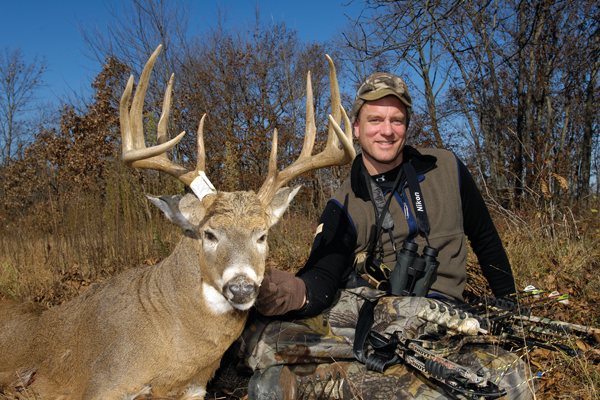December 15, 2014
By Bill Winke
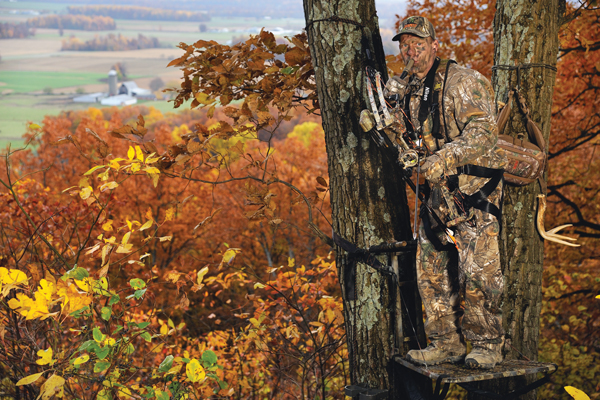 If you worked hard this summer, you likely found ways to extend your maximum effective shooting range by 10 yards. But by simply using a deer call properly, you can extend your maximum effective reach by at least 150 yards — and in the process double your success rate.
If you worked hard this summer, you likely found ways to extend your maximum effective shooting range by 10 yards. But by simply using a deer call properly, you can extend your maximum effective reach by at least 150 yards — and in the process double your success rate.
It is amazing how many bucks I have shot that came to the grunt call. In fact, about half the bucks I kill are lured into bow range after hearing a grunt call or a snort-wheeze. That means calling has literally doubled my success rate over the years. I can't say I would not have filled some of those tags later in the season by other means, but the stat is still amazing.
I am not doing anything magical with the call either, just blowing it a few times. If I have any secrets at all, they are knowing when to sound off and when to be quiet and how to read the body language of the bucks I am hunting. That is what this article is all about.
Advertisement
When Calling Works
You can't expect mature bucks to come running every time you puff air through a grunt tube. There are only certain situations when calling will work. I grunt at every shooter buck I see passing out of range, regardless of the time of the season. Overall, I'd say 10 to 20 percent actually end up coming within bow range. Obviously, I am not seeing tons of shooters each fall, and for every five to 10 I see, one comes in.
Some seasons I may not even see five shooters, so it is not as though the grunt saves my bacon every year, but it does often enough that I would never consider going afield without a grunt call tucked into a pocket where I can grab it quickly.
Advertisement
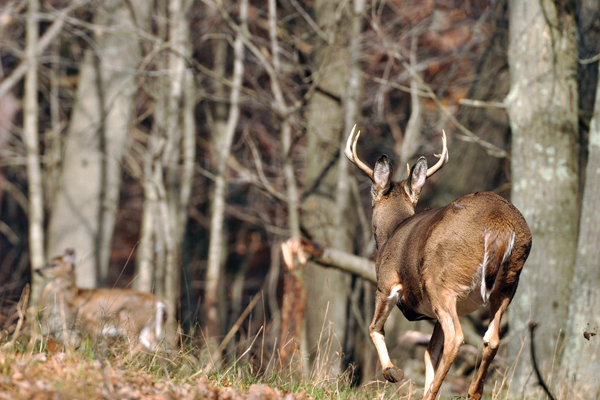 To further break down the response rate, I'll classify calling situations into four categories. First, consider the bucks that are just picking their way through the woods — not on a mission. I can turn nearly all of them with a simple grunt, and I'd guess that about a third end up coming all the way in.
To further break down the response rate, I'll classify calling situations into four categories. First, consider the bucks that are just picking their way through the woods — not on a mission. I can turn nearly all of them with a simple grunt, and I'd guess that about a third end up coming all the way in.
We could call the second category "mission impossible." When a buck is with an obviously hot doe, I've never pulled him even one step in my direction. You can usually tell them right away. There's no chasing, they are simply paired off and moving together.
Then there are the third and fourth categories: bucks that are alone but seem to have a destination in mind — on a mission — and bucks that are with does that don't seem to be in estrous yet. These deer won't come in immediately, but may come and check you out later. It happens a lot, but he may not return for 30 minutes or even a couple hours. I'd give this group about a 5 to 10 percent chance of responding. During the rut, it is very possible to encounter bucks in all four groups in one day.
Before you start comparing your success rate to mine, let me qualify my statistics by saying I hunt areas that receive some hunting pressure by other bowhunters but not a tremendous amount. Some of the deer I hunt have surely become educated to the fact that not all calls come from deer (one of the reasons I don't like blind calling), but the call-leery are in the minority.
If you hunt in areas that receive a lot of hunting pressure, you're calling success rates will be lower than mine, but that rate will still be better than zero. As little effort as it takes to blow into a grunt call, even a 5 percent call-in rate on shooter bucks is more than worth the trouble!
The Calling Sequence
You don't need a fancy strategy to call in bucks. Sure, there are times when maybe a buck roar or growl or hyperventilation grunt will pull in a buck that might not otherwise come in, but those situations are much rarer than call manufacturers would have you believe.
Simple works just fine. When I see a buck I want to get closer, I will start with a simple, mid-tone grunt. If he stops, I will give him one more to home in on. If he doesn't show any sign of stopping, I will raise the volume a bit with the next grunt. If he still doesn't respond, I hit him as hard as the call will allow without blowing down.
In other words, some grunt calls turn into duck calls if you blow them hard enough, others will hold their tone better at higher volumes. I test every grunt call first to make sure it holds its tone at high volumes. There are several that do, but the one I find myself carrying often is the Hardwood Grunter from Primos.
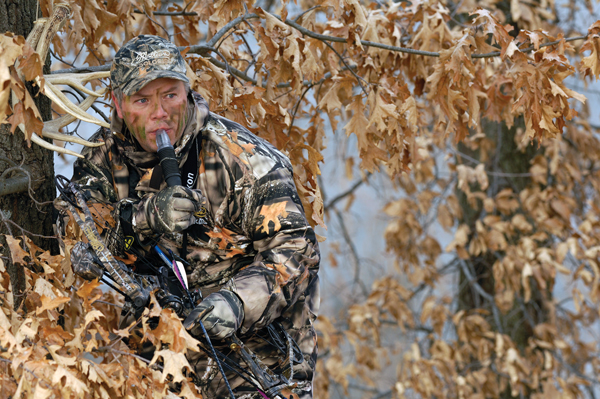 OK, so keep increasing the volume until the buck reacts to it. I really believe many times if the buck doesn't react it is because he doesn't hear the call or his mind is filled with other things. A breeze, crunching leaves and the buck's own distractions will limit how far he can hear the low, guttural tones of a grunt call.
OK, so keep increasing the volume until the buck reacts to it. I really believe many times if the buck doesn't react it is because he doesn't hear the call or his mind is filled with other things. A breeze, crunching leaves and the buck's own distractions will limit how far he can hear the low, guttural tones of a grunt call.
Don't be dismayed if he doesn't react after you hit him with a loud grunt. The next step is to move up to a call that carries better through the woods. I personally don't like carrying rattling antlers. They are a pain to carry and I have not felt I am missing anything by not rattling from my stands.
Rattling will carry farther through the woods and fields than a grunt call, so it is a logical next choice if the buck doesn't react to your grunt. My own progression is to move on to the snort-wheeze instead of rattling. Even though the snort-wheeze may not seem louder to us, it is at a higher pitch and that causes it to carry farther through the woods.
I have had bucks many times that didn't react to the grunt stop and stare at the first snort-wheeze. You can make the call with your mouth the way I do, or you can carry a little tube that will increase the volume slightly. Some call makers add these to their grunt calls.
Again, the main reason bucks don't stop and stare when you grunt is because they didn't hear it. Once they do stop, a different game of cat and mouse begins. You want to give them something to home in on — they may not have known exactly what they heard — but you don't want to push them off by being too aggressive.
I just give them one mid-volume grunt at this point and then remain quiet. That is usually all it takes. Either he is going to come or he isn't. No amount of fancy calling at this point will convince a suspicious buck to come in. More than likely, all that fancy calling will just cause him to be more suspicious.
Let him decide. If he walks your way, stay quiet. If he turns to leave, give him one more mid-volume grunt and then give it up.
The Perfect Tone
Not surprisingly, I am a bit of a connoisseur when it comes to grunt calls. So much of my success relies on them I feel the need to find those with the prefect tone for my ear. However, I am certain I obsess over this too much. I have heard the darndest sounds come from real deer — anywhere from long, 20-second, low grunts to noises that would better come from a pig lot. Anything that sounds like a buck will likely work.
There is no such thing as the perfect tone for a grunt call. Some hunters believe they should sound like an immature buck so as not to intimidate any mature deer. Well, I've heard a lot of immature bucks that sounded pretty tough and I've heard a lot of stud bucks that sounded a bit wimpy. Focus on volume and a good raspy tone and you will call in as many bucks as anyone.
Timing Is Important
One of our Midwest Whitetail pro staff members, Chad Lathrop, shot a buck in Missouri a few years ago — a giant 8-pointer — that he grunted in. He killed it on video, so I had a chance to see how he pulled it off. The buck was less than 90 degrees to the wind direction when Chad first saw him, and the deer was angling slightly away, heading further upwind.
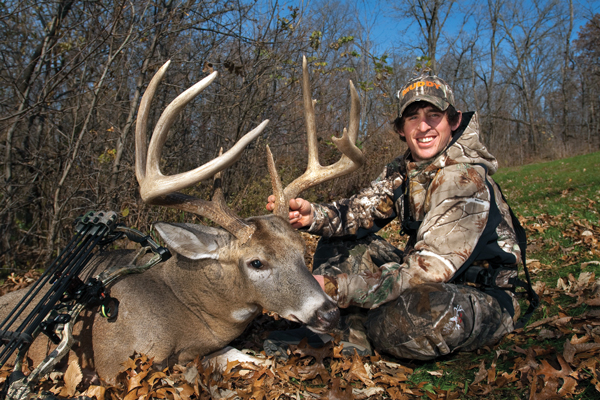 Chad was savvy enough to know that if he called too soon, the buck would first swing downwind before coming in and pick him off. Instead, he let the buck travel another 20 or 30 yards around his stand before calling to him.
Chad was savvy enough to know that if he called too soon, the buck would first swing downwind before coming in and pick him off. Instead, he let the buck travel another 20 or 30 yards around his stand before calling to him.
Now it was too far for the buck to get downwind first so he came straight in on a crosswind and Chad made a great, 10-yard shot. If he had called as soon as he saw the deer and realized it was not going to come closer, the shot likely never would have happened.
Another aspect of timing has to do with distance. I never call to bucks closer than about 60 yards unless the ground cover is very thick. At that close range, it is too easy for them to stop, look and not see another buck and then grow cautious and leave. I would rather let them walk a bit farther away and try to call them back than to try to move them toward me when it is obvious there is no buck at that base of my tree. They aren't stupid. If they hear a buck, they expect to see a buck. If they don't they know something is odd and they vacate. So, waiting to call until they can no longer look right through the woods to the base of your tree is a good idea.
Sometimes it still makes sense to wait even if the buck is more than 60 yards away. Again, it is all about visibility. If he can easily see the base of your tree, he can tell that there is no buck there and you had better wait to call to him until he can't see as easily.
Why I Don't Call Blindly
Like anything else you do in the woods, you can go overboard and call too much. The result is educated deer and more difficult hunting. Anytime you call attention to yourself in the woods, you take a risk. The buck that responds is going to come in looking for the source of the sound, and don't forget that source is you. In other words, he's looking for you. Bucks get old by being cautious when they move, and they play the game very well.
Calling deer definitely presents a tradeoff. The more you call, the more deer you will educate. It is that simple. In the process, you may also take a buck you like, but you run the very real risk of educating him first and never seeing him again. Or, he may respond to your calls by circling downwind through thick cover or behind some terrain and you may never even know you educated the biggest buck in the woods.
I know successful hunters who call every half hour, but they hunt big pieces of property with little hunting pressure. They can move around a lot and keep their stands in areas with fresh deer. If you hunt a small property, you can't afford to draw that kind of attention to your best stands.
The fear of educating bucks is why I only call to deer I've already seen. It is a kind of last resort strategy. If he's a shooter, I'll do anything I can to bring him within range. Since I can see him, I have better control over the situation — I can read his body language to know what to do next and I can track his progress as he sneaks in. But if he's not a shooter I won't make a sound. In fact, I'll be sitting there hoping he doesn't come anywhere near me. It's just never a good idea to educate deer, even if they aren't deer you want to shoot.
I hope I've made my case. Roughly half the bucks I have killed in my lifetime have come to the grunt call, including my biggest one. You can bet I always have one in my hip pocket ready for a quick draw.
Nothing else I carry, short of the treestand and the bow, has the power to increase my odds more than a simple grunt call. If you aren't making full use of this important tool, I want to thank you. You are leaving more bucks out there for me to shoot! It is time for you to take your fair share.
